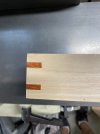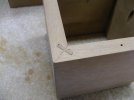You are using an out of date browser. It may not display this or other websites correctly.
You should upgrade or use an alternative browser.
You should upgrade or use an alternative browser.
Padauk splines / sawdust
- Thread starter Bill_L
- Start date
I would try hand planing with a sharp low-angle block plane instead of sanding. Sanding’s just going to make more dust.
As for mineral spirits, first try rubbing a piece of padauk scrap with a white cloth wet with mineral spirits. If any color comes off on the cloth mineral spirits might spread it to the birch.
As for mineral spirits, first try rubbing a piece of padauk scrap with a white cloth wet with mineral spirits. If any color comes off on the cloth mineral spirits might spread it to the birch.
We’d already tried the mineral spirits and it didn’t spread but good to keep in mind!I would try hand planing with a sharp low-angle block plane instead of sanding. Sanding’s just going to make more dust.
As for mineral spirits, first try rubbing a piece of padauk scrap with a white cloth wet with mineral spirits. If any color comes off on the cloth mineral spirits might spread it to the birch.
Try sealing the light colored wood BEFORE cutting the slots for the splines.
if you have a thickness sander, use it to ”sneak up” on the exact thickness of the spline material.
if you have a thickness sander, use it to ”sneak up” on the exact thickness of the spline material.
Seal with shellac…
I just had to check. From Wikipedia:
"(Play-Doh was) ...concocted by Noah McVicker of Cincinnati-based soap manufacturer Kutol Products. It was devised at the request of Kroger Grocery, which wanted a product that could clean coal residue from wallpaper."
I didn't know that!
Play-Doh is a good idea but any sticky stuff like masking tape would also do the same thing and would probably save you a trip to the toy store (or Amazon). Then, as others have said, Sealing the light-colored wood first would eliminate the need for either.
"(Play-Doh was) ...concocted by Noah McVicker of Cincinnati-based soap manufacturer Kutol Products. It was devised at the request of Kroger Grocery, which wanted a product that could clean coal residue from wallpaper."
I didn't know that!
Play-Doh is a good idea but any sticky stuff like masking tape would also do the same thing and would probably save you a trip to the toy store (or Amazon). Then, as others have said, Sealing the light-colored wood first would eliminate the need for either.
I'll seal before cutting the splines if I'm concerned about the woods. I'll try tape / sticky stuff (no card scraper). No sneaking up on the spline thickness as I don't have a thickness planer. There's so much I don't have when it comes to woodworking. The one thing I've used more than anything is a thin strip jig (from Fisher's Shop - like his videos and his presentation style). I must have cut a half dozen splines (too wide, too thin, too wide, too thin - I swear I barely moved the fence and even tried a folding sticky sheet of notepad paper to make the splines thinner). I like to make coasters so I'll have some nice padauk in the next set. Appreciate the feedback and I'll ask for any 'gotchas' BEFORE I start my next project.
Wow. Did not know that. History if full of things like this. Big fan of James Burke for his threads on history not based on the political/military timelines we had to memorize in school.Try white play doh. The stuff was invented to get soot off the wall, making it a toy was secondary. Or, try a lint brush that is the tape sticky kind that might work as well.
Have you tried cutting the splines over-sized and using a sander or plain sand paper to get to final thickness? A belt sander or random orbital sander would make quick work of it, but 80 grit sandpaper and sanding block would as well.
Our splines were initially cut oversized and then my son was sanding the splines. He tried using a sanding pad, then sandpaper on a block - just didn't feel like he was sanding evenly and the splines ended up with gaps. Rougher sandpaper like you suggested may be the way to go. Or, it may be time to get that sander ;-).
A belt sander is best for fine control of spline thickness, but I have used a tenon jig on my Unisaw to cut them. It is set so that the waste formed when cutting a tenon is the thickness desired and the resulting tenon becomes the waste. A donor board that's standing vertically in the jig will produce splines with the grain running across the narrow width.
For the grain to run the long way you can do the same, but put short pieces of wide boards in the jig with the grain running horizontally.
I use the cross grained splines for mitered corner joints like in the photo attached.
Charley
For the grain to run the long way you can do the same, but put short pieces of wide boards in the jig with the grain running horizontally.
I use the cross grained splines for mitered corner joints like in the photo attached.
Charley
Attachments
LATEST FOR SALE LISTINGS
-
-
SOLD -- $75: Gast moa v113 Vacuum Pump Veneer, 60" bag and board
- Started by peterdnight
- Replies: 1
-
GONE: Gladiator 5 cleats, 10 hangers, Paper Towel and Shelf
- Started by peterdnight
- Replies: 3
-
SOLD -- $100 Makita mac700 portable air + grex pin nailer + 2 others + 50' hose
- Started by peterdnight
- Replies: 1
-


